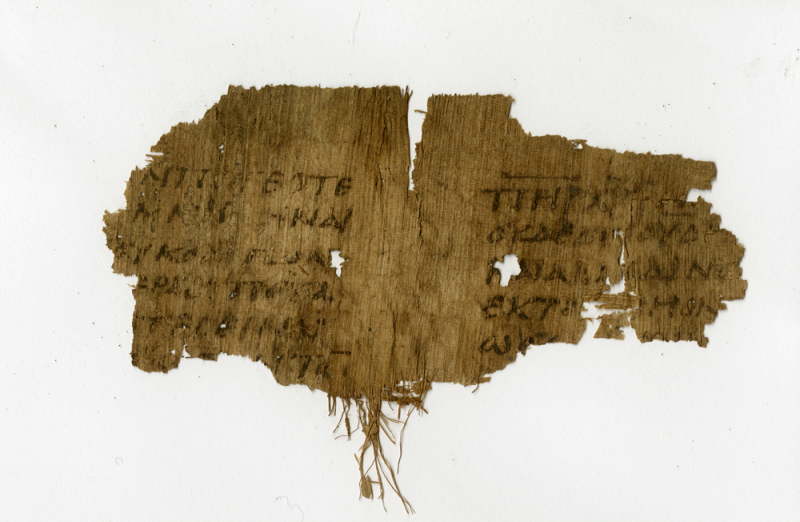
August 21, 2024
A Statutory Reading of the Nicene Creed

Fragment of a fifth-century papyrus codex containing the Nicene Creed. Courtesy of the Egypt Exploration Society. Photographer: Daniela Colomo.
| Two weeks ago, we were examining the Nicene Creed and comparing it to the Apostles’ Creed. I began reading it carefully using the plain meaning of the words in the Nicene Creed. What is Statutory Construction? Based on my past profession as a lawyer there is a concept called statutory construction. It begins with looking at the plain language of a statute to determine its original intent. To determine a statute’s original intent, courts first look to the words of the statute and apply their usual and ordinary meanings. This has been ingrained in me and is how I usually interpret written documents, including the Bible and BCP when giving them careful consideration. To me, it is initially a rational and literal analysis. I feel its application to a creed is appropriate. While “creed” is not captured in the Episcopal glossary of terms, Webster’s dictionary online defines the term as the brief authoritative formula of religious beliefs. If the clear meaning of the words does not provide the original intent of the statute you look to its legislative history for help to determine its meaning and intent. This legislative history of a statute contains discussions about the intent of the proposed language, its meaning in context and purpose, and is very helpful. It usually clarifies its intent for you to determine its meaning. However, in the end, you have to weigh these factors and make the final decision on its meaning for yourself. The Apostles’ Creed, Basis for the Nicene Creed As we noted earlier in an examination of the creeds, the Nicene Creed follows the format of the Apostles’ Creed in describing God the Father, his son, Jesus Christ, and the Holy Spirit (Ghost) but it expands these descriptions in an effort to provide a clearer profession of faith as decided by the council of Nicaea, and subsequent councils with further emphasis on the description of the Holy Spirit. Because of this more detailed profession of faith, this seems to be the reason for the use of the Nicene Creed in the Eucharist while the Apostles’ Creed is used in Daily Prayer and during a baptism. Applying Statutory Construction to the Nicene Creed. The Nicene creed is clearly divided into three parts, the first is belief in one God, the Father. The second is belief in one Lord, Jesus Christ. These seem to me to follow within the plain meaning of the words. It was not until the third part that I stopped and became confused with the description of the Holy Spirit. The third part reads as follows: We believe in the Holy Spirit, the Lord, the giver of life, who proceeds from the Father and the Son. With the Father and the Son he is worshiped and glorified. He has spoken through the Prophets. We believe in one holy catholic and apostolic Church. We acknowledge one baptism for the forgiveness of sins. We look for the resurrection of the dead, and the life of the world to come. Amen. The Apostles’ Creed simply says, “I believe in the Holy Ghost” (Spirit). What is the usual and ordinary meaning of Who Proceeds from? In particular, the usual and ordinary meaning of “Who proceeds from the Father and Son.” This led me to consider the plain meaning of the words in this phrase to determine their clear intent and meaning. I looked at the dictionary definition of proceeds which is defined as the money brought in from a transaction or event. Proceed is from the Latin procedere, meaning “go forward, advance,” and proceed is a verb that simply means to keep going, particularly after there’s been an interruption. This interpretation of Who goes forward from the Father and Son seems to lead to a chronological progression. Such a progression is an addition to the Apostles’ Creed section on the Holy Ghost (Spirit) which only states that, “I believe in the Holy Ghost”, without reference to the Father and/or Son. I then decided to look in the dictionary for the phrase, “proceeds from”. The dictionary definition for “proceeds from” is said to be formal and means to come from (a source). Using this, the phrase becomes, “Who comes from the Father and Son”. By this analysis, the usual and ordinary meaning of the phrase is that the Holy Spirit comes from the Father and Son. But this is contrary to what I have been taught and believe, which is the unity of the three. That is, the phrase to conform to my understanding, should read, “Who is one with the Father and Son. Considering the usual and ordinary meaning of the words as discussed above does not provide a reasonable explanation of my understanding of the concept as I have been taught, the next step is to consider the legislative history, which in this case is the events at the Council of Nicaea and subsequent councils which have led to the current version of the Nicene Creed. |
| The First Council of Nicaea, (325), was the first ecumenical council of the Christian church, meeting in ancient Nicaea (now İznik, Turkey). It was called by the emperor Constantine I, an unbaptized catechumen, who presided over the opening session and took part in the discussions. He hoped a general council of the church would solve the problem created in the Eastern church by Arianism, a heresy first proposed by Arius of Alexandria that affirmed that Christ is not divine but a created being. We will discuss the councils and issues before them and their conclusions which we leave until next week. |
| Thank you for your time and interest and blessings to you. |

Do you have any questions for the Camel? Questions about God, or Jesus, or the Church? About how to be Christian? Submit them via email to clergy@epiphanyec.org. Your name will be kept anonymous.
And a response will show up in a future Hump Day Message!
LAST Watermelon Wednesday TONIGHT, 6pm-8pm! The watermelon will be cold and the grill will be hot! Bring something for the grill and a side to share. Bring friends for this fun summer activity.
If it rains, it will be canceled and a message will be posted on FB and sent out in an email.
Thank you to everyone who participated in this year’s mid-year check-in to hear about how we are doing at Epiphany!



